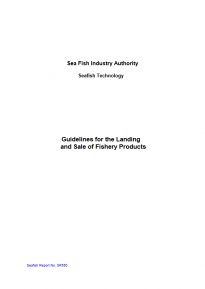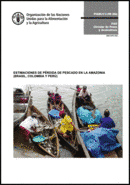Application of Appropriate Technology for Landing Sites in Small-Scale Fisheries
Technology associated with fish landing facilities and operations can assist in maintaining product quality and facilitate market access and trade thus reducing food loss and waste (FLW).
Fish Boxes and Containers
Fish Boxes and Containers
Fish boxes or containers protect the product from contamination and damage and make handling easy and quick.
Boxes and containers intended for use with fishery products must be constructed of materials that are durable, non-absorbent, corrosion resistant and easy to clean. High density polyethylene is recommended. Wooden boxes and wicker baskets are not suitable.
Containers for the storage of fish must have drainage holes except where the fish is stored in Refrigerated Seawater (RSW) or Chilled Sea Water (CSW) systems. They should be designed for efficient handling, both manually and mechanically.
Fish boxes and containers designed to interlock and stack together are recommended for efficient handling, storage and transport. Stack-boxes that are designed to nest together when empty have the advantage of requiring less storage space. Colour coding of the ends of stack-nest boxes aids the correct orientation of boxes when stacking and prevents crushing of fish and the de-stabilisation of stacks of boxes.
The design and materials of containers must be compatible with any washing machinery used. Lips and reinforcing webs that could trap water must have drainage holes. Plastic containers must be capable of withstanding the pressure and temperature of the hot water and detergents used.
Fish boxes and other containers including baskets and tubs used for discharge should have strong points for sling attachment. Fish boxes and other containers that are handled manually should have suitable hand holds. It is recommended that fish box and container design enable direct handling by mechanical equipment and be so sized to allow for efficient utilization of space during transport and distribution.
Ice
Ice
Chilling using ice prolongs the shelf-life of fish by slowing the action of enzymes, bacteria, and the chemical and physical processes that can affect quality. Fresh fish is an extremely perishable food and deteriorates very rapidly at normal temperatures. Reducing the temperature at which the fish is kept lowers the rate of deterioration.
The exact location of the ice-making facility can often be crucial to the success and viability of the operation. The needs of the end users of the ice should be carefully considered in final site selection. Installations are often built in locations considered best from an engineering standpoint, or because the site was cheap or land was deemed suitable by planners with little local knowledge of the site. Many such sites, whilst they may be only a short distance from the central fish harbour, can go virtually unused by fishermen because it is not convenient for them or within their normal patterns of operation to visit the location. End users must be consulted in site selection.
Plate and flake ice machines are normally located over the ice store enabling gravity feed of ice to the store with a consequent, considerable, reduction in ground area requirements. In all cases, storage space for empty fish boxes should be provided as well as ample water supply for cleaning and an area for box washing (preferably manually).
The ice plant should have sufficient capacity for the expected daily fish landings in the fish handling facility plus an additional production capacity if a fish collection system is also operated. The daily demand for ice can be estimated as follows:
ice for chilling of fish to be stored and transported for marketing outside the area and for un-sold fish which will be stored overnight and sold next day (e.g. A tons)
additional ice needed for a fish collection system (e.g. B tons)
required daily capacity of the ice plant (e.g. A + B tons)
The ice store should, at least, have the capacity to handle quantities sufficient for two days of ice production. The capacity of the chilled room for storage of iced fish should be calculated based on the expected market turnover. At a minimum, a capacity to store the average daily throughput of the fish landing facility should be provided; additional capacity would be needed if it is planned to operate a collection system.
Information and Communications Technologies (ICT)
Information and Communications Technologies (ICT)
Information and communications technologies (ICTs) refers to technologies that facilitate communication and the processing of information by electronic means and includes everything from radio and television to telephones (fixed and mobile), computers and the Internet. ICT is helping facilitate fish trade and market access.
Electronic auctions and real time security deposit follow-up, e.g. in Belgian, French and Dutch fish auctions markets allow remote web-based access to electronic auctions (2/3 of sales at French auctions are web-based).
Radio frequency identification device (RFID)-based smart boxes/crates allow for complete traceability. For example, French fishing ports are fitting such devices along the value chain from boat to market. Following landings, blockchain technology could secure remote payments in the future and better connect stakeholders along the value chain. USAID Oceans promotes a transparent and financially sustainable electronic Catch Documentation and Traceability system to help ensure that fisheries resources from Southeast Asia are legally caught and properly labelled.
Key Publications
Guidelines for the Landing and Sale of Fishery Products These guidelines provide advice on maintaining standards of fish quality and food safety, and on maximizing value through efficient landing and sale operations, and is an intended reference for trade and official bodies. | |
The Impact of ICT on Europe's Fishing Industry: A Case Study Approach This report presents the key issues facing the fishing industry today, based on a series of case studies that assessed the role of ICT as a driver of change in the fishing industry. | |
The Use of Ice on Small Fishing Vessels This publication describes the requirements for the use of ice and chilled seawater on board fishing vessels, and gives an overview of the different types of ice plants and the ice produced in them. |
More Resources
More Resources
31 October 2023














